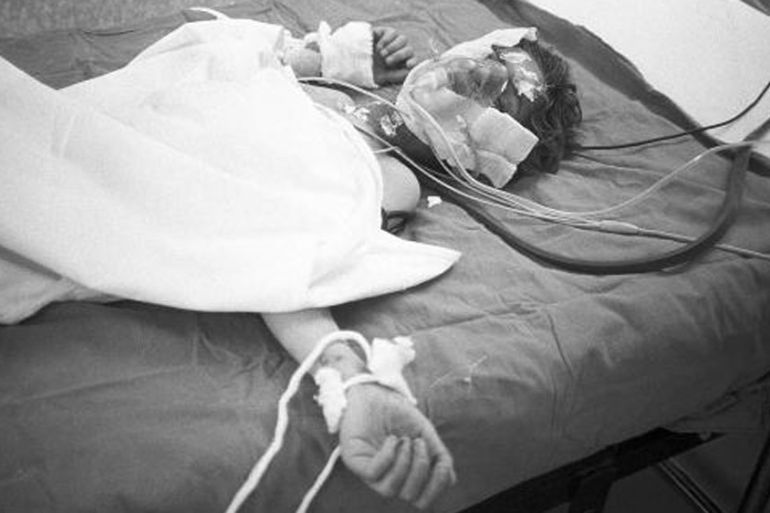Remembering Halabja chemical attack
Chemical weapons are the ultimate psychological weapon for those who are willing to use them.

On the morning of March 16, 1988, Iraqi war planes and artillery pounded the Kurdish town of Halabja in northern Iraq with mustard gas and the deadly nerve agent sarin.
Some 5,000 people – mainly women and children – died on the day, and up to 12,000 have lost their lives since. The method was the same as the Ghouta gas attack in Damascus, on August 21, 2013, just over 25 years later.
Keep reading
list of 4 items‘Mama we’re dying’: Only able to hear her kids in Gaza in their final days
Europe pledges to boost aid to Sudan on unwelcome war anniversary
Birth, death, escape: Three women’s struggle through Sudan’s war
In both instances a conventional pre-bombardment – to break windows and doors and to get people underground – was followed by the deadly chemical weapons, sarin and mustard agent.
Heavier than air – and with no windows and doors to stop the “gas” – it found its victims helpless and unprotected in underground cellars and air-raid shelters. These crimes against humanity were then followed up with a conventional bombardment to destroy the evidence.
Thankfully, as Adolf Hilter and Saddam Hussein eventually found out, there are always survivors of gas attacks aimed at annihilation – and justice will eventually prevail for the Islamic State of Iraq and the Levant (ISIL, also known as ISIS) and those in the Syrian regime responsible for Ghouta.
Some 28 years after Halabja, the Iraqi Kurds are once more under chemical attack from a tyranny, in this case under the banner of ISIL. On many occasions in the past two weeks, the Peshmerga, the fighting force of the Kurdistan Regional Government of Iraq, has been under chemical bombardment from ISIL.
This home-made “dusty” mustard – though not as toxic as the liquid produced by Saddam and the Syrian regime – has still killed a number and injured hundreds.
Last year, ISIL reportedly used the mustard agent a number of times against the Peshmerga in the Mosul Dam area, and against civilians in the northern Syrian town of Marea.
It is highly likely that without that no-fly zone, we would have seen millions of Iraqi Kurd refugees in Europe, as Saddam was bent on their extermination, which began with the Anfal campaign of the 1980s, and is synonymous with the poisonous gas attack on Halabja in 1988.
Reports from Iraq over the past weekend claimed that ISIL launched a chemical attack in Taza, near Tikrit, with mustard agent on two occasions, killing one person and injuring 600.
The Peshmerga is well familiar with chemical attacks, and many experienced the complete range at Halabja and in dozens of chemical attacks during the Anfal campaign.
Now they face this most terrifying of weapons again from ISIL with little or no protection.
However, some protection and knowledge will not only undoubtedly save lives but will also nullify this weapon that threatens to tip the balance of this battle in ISIL’s favour – especially if Western forces do not commit ground troops with chemical warfare experience.
It is the Iraqi Kurdish Peshmerga forces, who are putting up the sternest fight on the ground against ISIL. But if a “no-fly zone” and “safe havens” were in place in Syria and Iraq – similar to the ones imposed by the United States-led coalition in 1991, which stopped Saddam forces annihilating the Iraqi Kurds – they probably would be pushing ISIL forces back towards Mosul and then Raqqa.
It is highly likely that without that no-fly zone, we would have seen millions of Iraqi Kurd refugees in Europe, as Saddam was bent on their extermination, which began with the Anfal campaign of the 1980s, and is synonymous with the poisonous gas attack on Halabja in 1988.
OPINION: Safe havens are needed in Syria – more than ever
The fear of chemical weapons is the real terror of war. Less than 0.5 percent of casualties during World War I were attributed to chemical weapons, yet the Great War has become synonymous with their use.The current conflict in Syria and Iraq depicts a similar picture.
ISIL employs a morbidly brilliant psychological warfare, and chemical weapons are the ultimate psychological weapon against all their enemies.

As ISIL loses more ground and gets pushed back towards Raqqa, it will use every means at its disposal to hold off defeat. In the aftermath of Taza and Sinjar attacks, chemical weapons could be employed again.
If the Peshmerga and the Iraqi army can take Mosul and push ISIL out of Iraq, the defeat of the terror group on the ground will be in sight. With that the chances for some sort of stability in the region will be in our collective grasp.
But first these ground troops must be prepared for more chemical attacks, and the West must not let the Kurds down again and leave them to face another Halabja.
Hamish de Bretton-Gordon is a chemical weapons adviser to NGOs working in Syria and Iraq. He is a former commanding officer of the UK Chemical, Biological, Radiological and Nuclear (CBRN) Regiment and NATO’s Rapid Reaction CBRN Battalion.
The views expressed in this article are the author’s own and do not necessarily reflect Al Jazeera’s editorial policy.
